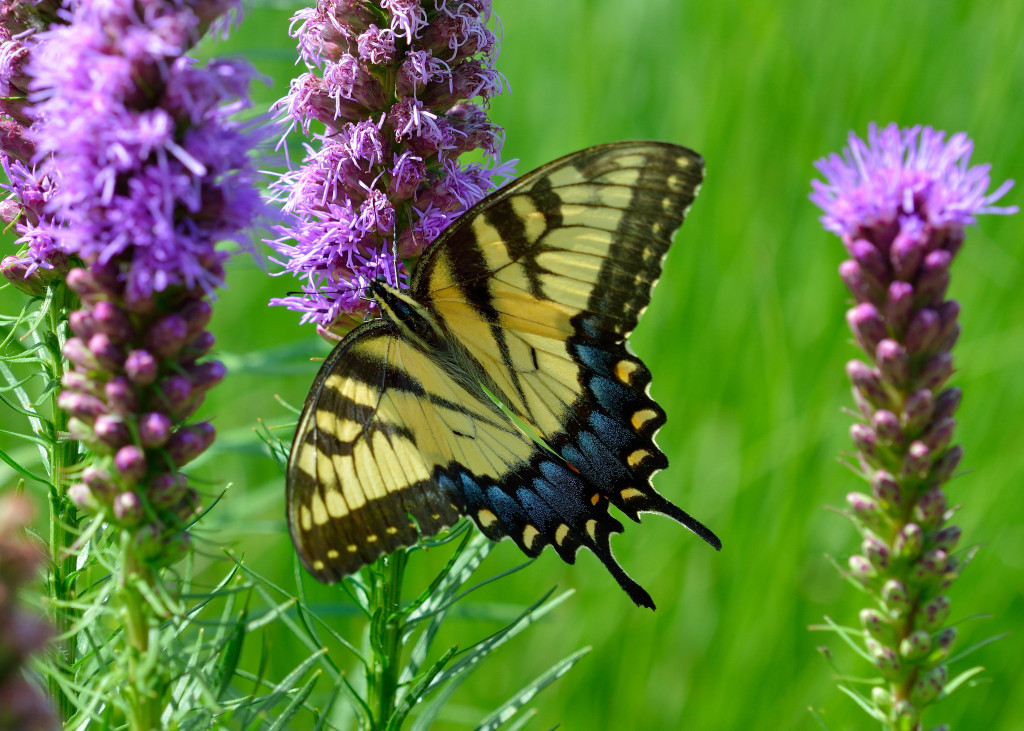
By Olivia DaRugna, Watchable Wildlife Biologist
While birds are celebrated during the month of May, it’s time to transition our focus to other incredible animals to watch in Nebraska. Let’s take a look at butterflies in June, and unlike birds, you don’t have to wake up early to enjoy these pretty insects. Brunch and then butterflies, anyone?
You don’t have to go far or search very long to see butterflies. Just sit in your yard or local park, and you will likely see a variety of species. Of the approximately 750 butterfly species found in North America, 211 occur in Nebraska, and they come in different colors and sizes. Some species can be choosy about habitats and flowers, while other butterflies are more widespread across the state.
Common Nebraska Butterflies
Commonly observed butterflies in Nebraska include the red admiral (Vanessa atalanta) and beautiful yellow- and black-colored species of swallowtails, with their large wingspans stretching three to five inches. The eastern tiger swallowtail (Pterourus glaucus) and the black swallowtail (Papilio polyxenescan) are commonly seen throughout the state, along with other less common swallowtails, such as the two-tailed swallowtail (Pterourus multicaudata).
The cabbage white (Pieris rapae) stands out in urban yards and gardens with its almost all-white coloration. This species was introduced to North America from Europe and has since spread throughout much of the continent. Two other “urban” butterfly species include the clouded sulphur (Colias philodice) and orange sulphur (Colias eurytheme), which are yellow to orange.
Some butterflies have distinct shapes that can help you identify them. While most butterflies have smooth, rounded wings, others have wing outer edges, or margins, that look uneven and ragged – like torn pieces of paper. The question mark (Polygonia interrogationis) and the eastern comma (Polygonia comma) almost resemble dead leaves when their ragged wings are folded. Both species are named for the silver markings on their hind wings. You may see either species while exploring woodlands or wooded urban parks throughout Nebraska.
Not all butterfly species are easily identifiable, and that is when a camera and field guide can come in handy. The fritillaries and crescents can be difficult to distinguish. Luckily, there are great tips to help you distinguish between different species on the Nebraska Lepidoptera website.
Butterflies are fascinating creatures and, like birds, some species of butterflies, such as monarchs, migrate long distances. Monarch butterflies get a lot of attention, so let’s look at the painted lady (Vanessa carduii), which is the most widespread butterfly species in the world, inhabiting every continent except Antarctica and Australia.
In Nebraska, the painted lady has been observed in every county and in a variety of habitats. This species has impressive, but sporadic, migrations that span about six generations from Mexico to Canada and back. Large clusters of thousands of painted lady butterflies can sometimes be seen and even picked up on weather radar during their migrations. Unlike monarchs, the painted lady breeds on its migration south and thus, needs host plants, like thistles and mallows, to lay its eggs and the caterpillars to eat. Watch for large cluster of these butterflies flying around in June.
The Nebraska Lepidoptera website features images, range maps and lots of other helpful information for viewing and identifying butterflies in Nebraska. Find your next butterfly adventure by using the map of recommend locations for viewing a variety of species. Don’t forget to pack a picnic brunch or stop somewhere for a bite en route. Brunch then butterflies — can it get any better?
How to Help Butterflies
We are looking for volunteers to help with Nebraska’s monarch and regal fritillary surveys this summer. No matter where you are located in the state, you can sign up to do surveys for these at-risk butterflies. The data collected from these surveys is used for monitoring and conservation efforts. To learn more and to sign up to volunteer, click here.
You also can help butterflies by planting a diversity of native flowers, grasses, shrubs and trees in your yard. Butterflies not only need flowers for nectar, but they also need foliage for shelter and places to lay their eggs. Native pollinator patches can be as small as a container on your patio to as big as your entire yard or field. Best of all, native plants are adapted for this climate and do not require as much water or care once they are established. The Nebraska Statewide Arboretum has great resources about native plants that are attractive to pollinators. Visit Plant Nebraska to learn more.
Wildlife Viewing Events in June
Monarch and Regal Fritillary Surveys start! Sign up today to volunteer for this great community science project.
Nebraska Bumble Bee Atlas starts in June! You can sign up to help with this statewide community science project aimed at tracking and conserving native bumble bees in Nebraska.
Wildflower Week is June 5-11. To celebrate, there will be wildflower outings held at Chadron State Park and Wildcat Hills State Recreation Area, as well as other events around the state.
Pollinator Week is June 19- 25. There will be a variety of activities to celebrate pollinators during this week. Submit your pollinator observations to iNaturalist for the Nebraska Pollinator Quest.
Ash Hollow State Historical Site Bioblitz is June 17. Come learn about and see lots of wildlife.
Neighborhood Nature Fest is June 21 at Benson Park in Omaha. This event is all about celebrating our nature neighbors.
